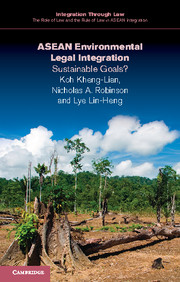Book contents
- Frontmatter
- Contents
- List of tables
- General editors’ preface
- Foreword – Professor Tommy
- Acknowledgments
- Introduction: exploring environmental law in Southeast Asia
- 1 ASEAN and environmental sustainability
- 2 Integrating sustainability into ASEAN state practice
- 3 The environment in the ASEAN region
- 4 Environmental sustainability laws in the ASEAN member states
- 5 ASEAN collaboration towards environmental sustainability
- 6 ASEAN and climate disruption
- 7 Conclusions: ASEAN's challenging way forward
- Executive summary
- Appendix A ASEAN organizational structure relevant to the environment – the ASEAN Charter
- Appendix B Founding of ASEAN – a short history
- Index
Appendix B - Founding of ASEAN – a short history
Published online by Cambridge University Press: 05 April 2016
- Frontmatter
- Contents
- List of tables
- General editors’ preface
- Foreword – Professor Tommy
- Acknowledgments
- Introduction: exploring environmental law in Southeast Asia
- 1 ASEAN and environmental sustainability
- 2 Integrating sustainability into ASEAN state practice
- 3 The environment in the ASEAN region
- 4 Environmental sustainability laws in the ASEAN member states
- 5 ASEAN collaboration towards environmental sustainability
- 6 ASEAN and climate disruption
- 7 Conclusions: ASEAN's challenging way forward
- Executive summary
- Appendix A ASEAN organizational structure relevant to the environment – the ASEAN Charter
- Appendix B Founding of ASEAN – a short history
- Index
Summary
From the ASEAN web page: www.asean.org/asean/about-asean/history
On August 8, 1967, five leaders – the Foreign Ministers of Indonesia, Malaysia, the Philippines, Singapore and Thailand – sat down together in the main hall of the Department of Foreign Affairs building in Bangkok, Thailand and signed a document. By virtue of that document, the Association of Southeast Asian Nations (ASEAN) was born. The five Foreign Mini sters who signed it – Adam Malik of Indonesia, Narciso R. Ramos of the Philippines, Tun Abdul Razak of Malaysia, S. Rajaratnam of Singapore and Thanat Khoman of Thailand – would subsequently be hailed as the Founding Fathers of probably the most successful intergovernmental organization in the developing world today. And the document that they signed would be known as the ASEAN Declaration.
It was a short, simply-worded document containing just five articles. It declared the establishment of an Association for Regional Cooperation among the Countries of Southeast Asia to be known as the Association of Southeast Asian Nations (ASEAN) and spelled out the aims and purposes of that Association. These aims and purposes were about cooperation in the economic, social, cultural, technical, educational and other fields, and in the promotion of regional peace and stability through abiding respect for justice and the rule of law and adherence to the principles of the United Nations Charter. It stipulated that the Association would be open for participation by all States in the Southeast Asian region subscribing to its aims, principles and purposes. It proclaimed ASEAN as representing “the collective will of the nations of Southeast Asia to bind themselves together in friendship and cooperation and, through joint efforts and sacrifices, secure for their peoples and for posterity the blessings of peace, freedom and prosperity.”
It was while Thailand was brokering reconciliation among Indonesia, the Philippines and Malaysia over certain disputes that it dawned on the four countries that the moment for regional cooperation had come or the future of the region would remain uncertain. Recalls one of the two surviving protagonists of that historic process, Thanat Khoman of Thailand: “At the banquet marking the reconciliation between the three disputants, I broached the idea of forming another organization for regional cooperation with Adam Malik. Malik agreed without hesitation but asked for time to talk with his government and also to normalize relations with Malaysia now that the confrontation was over.
- Type
- Chapter
- Information
- ASEAN Environmental Legal IntegrationSustainable Goals?, pp. 229 - 239Publisher: Cambridge University PressPrint publication year: 2016



